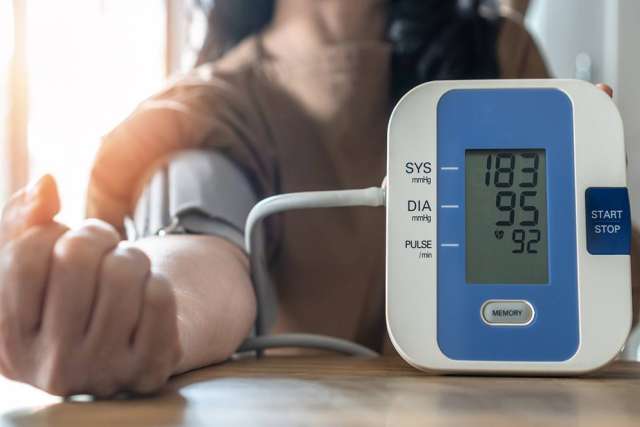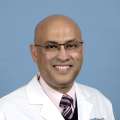Nearly 116 million adults in the United States have been diagnosed with high blood pressure, according to the Centers for Disease Control and Prevention. Most of those with high pressure are taking medication.
High blood pressure, also referred to as hypertension, was the leading cause of death for more than a half million people in the U.S. in 2019.
Despite those daunting numbers, Dr. Anjay Rastogi, MD, PhD, clinical chief of nephrology at the David Geffen School of Medicine at UCLA, said there is a remedy. It starts with the discipline of the individuals diagnosed with hypertension.
“The first thing we have to address is the lifestyle changes,” Dr. Rastogi said. “I always tell my patients, ‘I can give you a pill that will take care of the blood pressure, most likely, but I would be doing a disservice if I didn’t address your salt intake.’”
Dr. Rastogi is referring to the high intake of sodium chloride, or table salt. The ingredient, found in a lot of packaged foods and restaurant food, is linked to hypertension in many people.
“Sodium is potentially bad for multiple reasons but especially for blood pressure,” Dr. Rastogi continued. “Diets that are generally higher in potassium are better for normalizing hypertension.”
What is high blood pressure and what causes it?
Blood pressure is the measurement of the force the heart uses to pump blood, providing nutrients to the body’s tissues and organs.
“The problem is when the blood pressure gets too high or too low,” Dr. Rastogi said.
High blood pressure can be caused by many variables including:
- Diet high in sodium
- Obesity
- Smoking
- Stress
- Excessive alcohol consumption
- Medications for other ailments (i.e. Aleve, ibuprofen, Motrin IB, Advil )
- Stress
- Age
- Genetics
Symptoms of high blood pressure
People who have high blood pressure might experience multiple symptoms, such as:
- Headaches
- Nose bleeds
- Blurred vision
- Difficulty breathing
- Chest pain
- Blood in the urine
- Irregular heartbeat
Understanding blood pressure readings
Normally, when we go in for a doctor visit, we are greeted by a nurse who conducts a preliminary screening of our weight, height and then our blood pressure. Though we may be familiar with the device strapped to our arm, we may not quite understand the numbers that it measures.
You may hear the doctor say your blood pressure is “120 over 75,” written 120/75. The first number is your systolic blood pressure, the measure of the pressure in your arteries when the hearts beats. The second number is your diastolic blood pressure, the measure of blood pressure when the heart rests between beats.
The American Heart Association blood pressure chart shows that normal blood pressure readings are in the 120/80 range.
“Anything over 130/80 is considered high blood pressure,” Dr. Rastogi explained. “However, there are many factors that can lead to increased blood pressure measurements.”
He said if a person is rushing because they are running late to their doctor appointment or if they had a caffeinated beverage before the visit, they could be susceptible to a higher blood pressure reading. Ideally, a person should be relaxed before having their blood pressure checked.
“You should be in a quiet room and you need to be calm before your blood pressure test. Everyone needs to take a moment to calm themselves before the blood pressure monitor is put on. Though it’s not typically done, the nurse should take three readings to get a more accurate measurement,” Dr. Rastogi said.
He also suggested that people purchase their own blood pressure monitors for home use. The devices, which can be found at most pharmacies, are a good way for patients to track blood pressure levels on a regular basis.

Regulating blood pressure
Dr. Rastogi stated that when it comes to treating hypertension, one fix does not fit all. However, he said, lifestyle changes are more effective than medicine.
“The traditional way to treat blood pressure is to recommend lifestyle changes to the patient and tell them to come back in three months,” he said. “After three months, if their blood pressure is still high we can give them the medication.”
However, Dr. Rastogi uses a different approach when treating his patients.
“The best way is to present them with lifestyle change recommendations and prescribe them medication at the same time,” he said. “If they come back after three months with better BP readings due to lifestyle changes, then I pull back on the medications.”
There are more than 200 medicines currently available to treat high blood pressure. However, they are only temporary fixes if the patient is not moving toward a healthier lifestyle.
Change in mindset = change in lifestyle = change in blood pressure
“When you look at hypertension, heart disease, diabetes and heart failure, human psychology really plays a big part,” said Dr. Rastogi. “We don’t focus on that enough. You start to ask yourself, ‘Why do people do things that they know will kill them eventually?’”
The answer to that question often comes back to a lack of understanding, depression, anxiety or giving up altogether, as Dr. Rastogi explains it.
There are a few key strategies people can adopt to help lower their blood pressure:
- Quit smoking
- Commit to a healthy diet with more fruits and vegetables (five servings daily)
- Begin exercising (start with something small, such as walking outside for five to 10 minutes daily, and build up gradually)
- Limit your intake of foods that are high in sugar and sodium
- Eat foods that are high in potassium (beets, avocado, spinach, white beans, black beans, watermelon)
- Avoid fried foods or deep-fried foods, which are known to clog arteries
- Hydrate frequently with water or healthy drinks filled with antioxidants
“Hypertension is a silent disease until it manifests. When it manifests, it leads to a stroke or heart failure or a heart attack,” Dr. Rastogi said.
“Bad habits start in the mind. Once we begin to address those psychologically and change them, then we can make the lifestyle changes necessary to give us a healthier life.”
If you have questions or concerns about high blood pressure please visit UCLA Nephrology.




